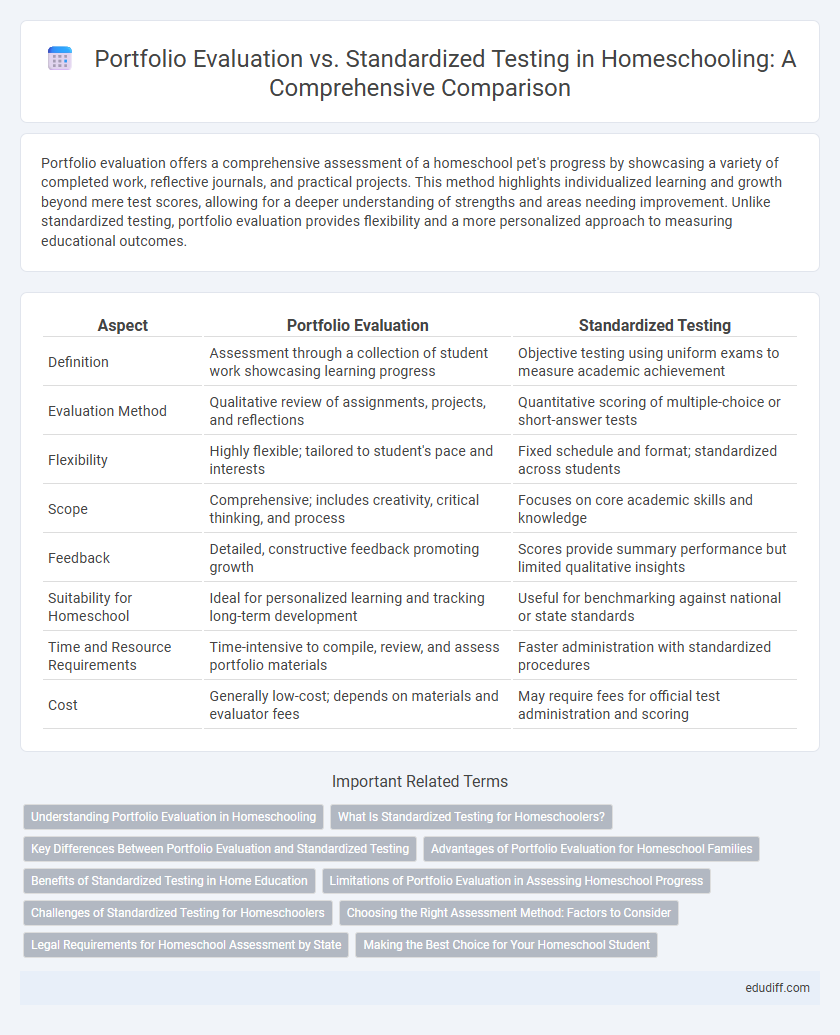Portfolio evaluation offers a comprehensive assessment of a homeschool pet's progress by showcasing a variety of completed work, reflective journals, and practical projects. This method highlights individualized learning and growth beyond mere test scores, allowing for a deeper understanding of strengths and areas needing improvement. Unlike standardized testing, portfolio evaluation provides flexibility and a more personalized approach to measuring educational outcomes.
Table of Comparison
| Aspect | Portfolio Evaluation | Standardized Testing |
|---|---|---|
| Definition | Assessment through a collection of student work showcasing learning progress | Objective testing using uniform exams to measure academic achievement |
| Evaluation Method | Qualitative review of assignments, projects, and reflections | Quantitative scoring of multiple-choice or short-answer tests |
| Flexibility | Highly flexible; tailored to student's pace and interests | Fixed schedule and format; standardized across students |
| Scope | Comprehensive; includes creativity, critical thinking, and process | Focuses on core academic skills and knowledge |
| Feedback | Detailed, constructive feedback promoting growth | Scores provide summary performance but limited qualitative insights |
| Suitability for Homeschool | Ideal for personalized learning and tracking long-term development | Useful for benchmarking against national or state standards |
| Time and Resource Requirements | Time-intensive to compile, review, and assess portfolio materials | Faster administration with standardized procedures |
| Cost | Generally low-cost; depends on materials and evaluator fees | May require fees for official test administration and scoring |
Understanding Portfolio Evaluation in Homeschooling
Portfolio evaluation in homeschooling offers a comprehensive assessment method by compiling a student's work samples, projects, and progress over time, reflecting individualized learning styles and strengths. Unlike standardized testing, which measures performance at a single point with uniform criteria, portfolio evaluation emphasizes growth, creativity, and mastery of subject matter tailored to the homeschool curriculum. This approach enables parents and educators to document academic development while fostering a deeper understanding of the child's educational journey.
What Is Standardized Testing for Homeschoolers?
Standardized testing for homeschoolers involves structured assessments designed to measure academic achievement relative to national or state benchmarks. These tests provide quantifiable data on student performance in subjects like math, reading, and language arts, offering a consistent gauge for progress. Homeschool families often use standardized tests to fulfill state requirements, guide instruction, and prepare students for college admissions.
Key Differences Between Portfolio Evaluation and Standardized Testing
Portfolio evaluation in homeschooling emphasizes individualized student work samples, progress documentation, and skill mastery over time, offering a comprehensive view of a learner's development. Standardized testing measures student performance through uniform exams, focusing on comparative data and grade-level benchmarks. Portfolio assessment fosters critical thinking and creativity, while standardized tests primarily evaluate recall and standardized content knowledge.
Advantages of Portfolio Evaluation for Homeschool Families
Portfolio evaluation in homeschooling offers personalized assessment by showcasing diverse student work over time, reflecting individual growth and creativity beyond test scores. It allows parents to tailor learning documentation to highlight strengths, skills, and unique interests, providing a comprehensive picture of academic progress. This method fosters intrinsic motivation and accommodates varied learning styles, making it ideal for adapting to the flexible nature of homeschooling curricula.
Benefits of Standardized Testing in Home Education
Standardized testing in home education provides objective benchmarks that help measure student progress against national or state academic standards. It offers consistent data for identifying strengths and areas needing improvement, facilitating targeted instruction and personalized learning plans. Moreover, standardized testing enhances credibility and acceptance of homeschool transcripts in college admissions and scholarship applications.
Limitations of Portfolio Evaluation in Assessing Homeschool Progress
Portfolio evaluation in homeschooling often faces limitations such as inconsistent criteria, making it difficult to measure academic progress uniformly across different subjects. This assessment method may lack the objectivity of standardized testing, leading to potential biases in evaluating a student's true capabilities. Furthermore, portfolio reviews can be time-intensive and may not adequately capture a student's performance under varied or high-pressure testing conditions.
Challenges of Standardized Testing for Homeschoolers
Standardized testing often presents significant challenges for homeschoolers due to its rigid format and limited flexibility, which can fail to accommodate diverse learning styles and individualized curricula. Homeschool portfolios, encompassing a comprehensive collection of work samples, projects, and assessments, provide a more personalized and accurate representation of a student's progress and abilities. The lack of alignment between standardized test content and homeschool instruction frequently results in misrepresentations of a homeschooler's true academic performance and growth.
Choosing the Right Assessment Method: Factors to Consider
Choosing the right assessment method for homeschool students depends on factors such as learning style, educational goals, and state requirements. Portfolio evaluation allows for a comprehensive view of a child's progress, showcasing creativity, critical thinking, and varied skills over time. Standardized testing offers measurable benchmarks for academic performance and can simplify compliance with state laws, making it essential to balance both methods according to individual needs and legal demands.
Legal Requirements for Homeschool Assessment by State
Homeschool parents must navigate varying legal requirements for assessment methods, with some states mandating portfolio evaluation while others require standardized testing to demonstrate academic progress. Portfolio evaluations involve a comprehensive collection of student work showcasing learning over time, offering a flexible and personalized record preferred in states like California and Texas. In contrast, states such as New York and Pennsylvania enforce standardized testing or equivalent assessments to ensure compliance, emphasizing uniform measures of student achievement.
Making the Best Choice for Your Homeschool Student
Portfolio evaluation offers a comprehensive view of a homeschool student's progress by showcasing diverse work samples, critical thinking, and creativity, unlike standardized testing which measures performance through uniform metrics. Choosing portfolio evaluation allows personalized assessment aligned with the student's learning style and growth trajectory, fostering deeper understanding and skill mastery. Standardized tests provide benchmarks for academic standards but may not fully capture individual strengths or unique learning paths in a homeschooling environment.
Portfolio Evaluation vs Standardized Testing Infographic

 edudiff.com
edudiff.com